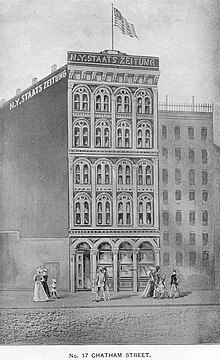Neue-Yorker Staats-Zeitung

Staats-Zeitung Building, 1857-1873
|
|
| Type | Weekly newspaper |
|---|---|
| Owner(s) | Jes Rau |
| Founded | 1834 |
| Language | German |
| Headquarters | Sarasota, Florida |
| ISSN | 1542-1465 |
| Website | http://www.germancorner.com/NYStaatsZ/ |
The New Yorker Staats-Zeitung, nicknamed "The Staats", claims to be the leading German-language weekly newspaper in the United States and is one of the oldest, having been published since the mid-1830s. In the late 1800s it was one of New York City's major daily newspapers, exceeded in circulation only by the New York World and the New York Tribune. Among other achievements, as of its sesquicentennial anniversary in 1984 it had never missed a publication date, thereby laying claim to the title of being continuously published longer than any other newspaper (of any language) in America.
The Staats-Zeitung was founded in New York City in 1834 by a society of German-American businessmen. The partners included George Zahm, Stepan Molitor, Conrad Braeker, and Gustav Adolph Neumann, with Neumann serving as editor-in-chief (as well as reporter and production foreman). Neumann subsequently purchased shares of the enterprise until, in the late 1830s, he obtained a majority, after which the society was dissolved and he became sole owner.
The first issue was published on December 24, 1834. The nascent newspaper consisted of four pages and was printed weekly using a Washington hand-press. Initial circulation was small, limited by the capacity of the press (2000 impressions per day) and by the size of the audience (primarily German immigrants). At that time there were approximately 10,000 German-born citizens in New York City.
Growth during the first few years of the paper's existence was also impeded by the Financial Panic of 1837, but by 1839 it was sufficiently successful to move to a location on Frankfort Street, a few blocks from City Hall. Under Neumann's guidance, improvements to the physical plant were undertaken to support the growth that accompanied its increasing influence. In 1843, on obtaining a single cylinder hand-operated press that could print 600 sheets per hour, he converted the Staats-Zeitung to a tri-weekly publication.
The paper's staff also expanded as it grew. Notable additions included: Jacob Uhl, who may have been hired as a printer as early as 1836; Jacob's wife Anna Uhl, who worked as a compositor, secretary, and business manager; and Oswald Ottendorfer, who appears to have been hired in the counting room in 1850. All had a role to play in the unfolding story.
...
Wikipedia
